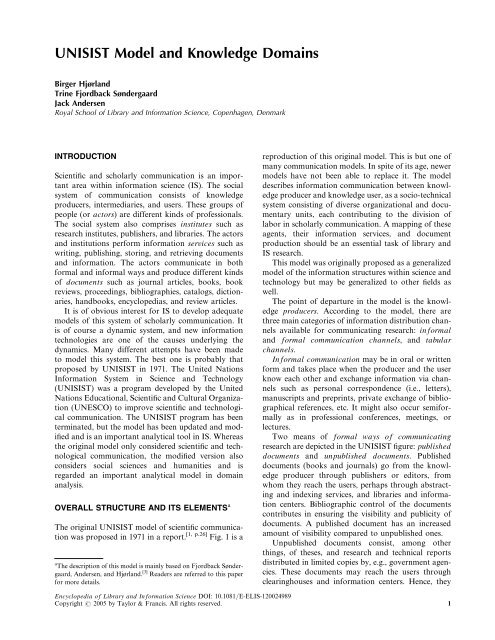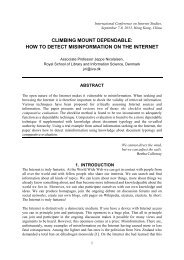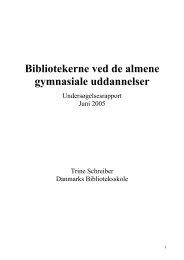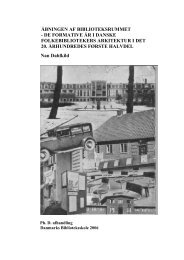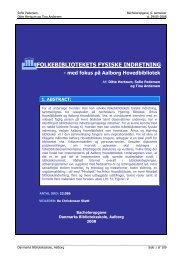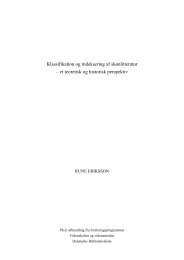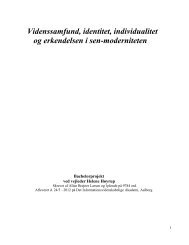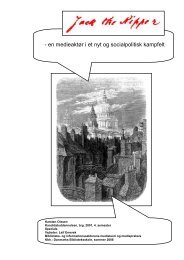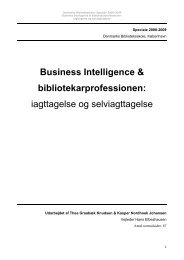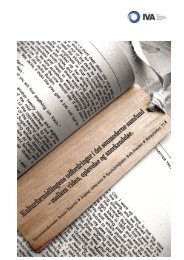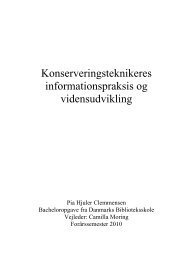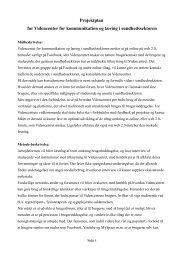UNISIST Model and Knowledge Domains
UNISIST Model and Knowledge Domains
UNISIST Model and Knowledge Domains
Create successful ePaper yourself
Turn your PDF publications into a flip-book with our unique Google optimized e-Paper software.
<strong>UNISIST</strong> <strong>Model</strong> <strong>and</strong> <strong>Knowledge</strong> <strong>Domains</strong><br />
Birger Hjørl<strong>and</strong><br />
Trine Fjordback Søndergaard<br />
Jack Andersen<br />
Royal School of Library <strong>and</strong> Information Science, Copenhagen, Denmark<br />
INTRODUCTION<br />
Scientific <strong>and</strong> scholarly communication is an important<br />
area within information science (IS). The social<br />
system of communication consists of knowledge<br />
producers, intermediaries, <strong>and</strong> users. These groups of<br />
people (or actors) are different kinds of professionals.<br />
The social system also comprises institutes such as<br />
research institutes, publishers, <strong>and</strong> libraries. The actors<br />
<strong>and</strong> institutions perform information services such as<br />
writing, publishing, storing, <strong>and</strong> retrieving documents<br />
<strong>and</strong> information. The actors communicate in both<br />
formal <strong>and</strong> informal ways <strong>and</strong> produce different kinds<br />
of documents such as journal articles, books, book<br />
reviews, proceedings, bibliographies, catalogs, dictionaries,<br />
h<strong>and</strong>books, encyclopedias, <strong>and</strong> review articles.<br />
It is of obvious interest for IS to develop adequate<br />
models of this system of scholarly communication. It<br />
is of course a dynamic system, <strong>and</strong> new information<br />
technologies are one of the causes underlying the<br />
dynamics. Many different attempts have been made<br />
to model this system. The best one is probably that<br />
proposed by <strong>UNISIST</strong> in 1971. The United Nations<br />
Information System in Science <strong>and</strong> Technology<br />
(<strong>UNISIST</strong>) was a program developed by the United<br />
Nations Educational, Scientific <strong>and</strong> Cultural Organization<br />
(UNESCO) to improve scientific <strong>and</strong> technological<br />
communication. The <strong>UNISIST</strong> program has been<br />
terminated, but the model has been updated <strong>and</strong> modified<br />
<strong>and</strong> is an important analytical tool in IS. Whereas<br />
the original model only considered scientific <strong>and</strong> technological<br />
communication, the modified version also<br />
considers social sciences <strong>and</strong> humanities <strong>and</strong> is<br />
regarded an important analytical model in domain<br />
analysis.<br />
OVERALL STRUCTURE AND ITS ELEMENTS a<br />
The original <strong>UNISIST</strong> model of scientific communication<br />
was proposed in 1971 in a report. [1, p.26] Fig. 1 is a<br />
a The description of this model is mainly based on Fjordback Søndergaard,<br />
Andersen, <strong>and</strong> Hjørl<strong>and</strong>. [3] Readers are referred to this paper<br />
for more details.<br />
reproduction of this original model. This is but one of<br />
many communication models. In spite of its age, newer<br />
models have not been able to replace it. The model<br />
describes information communication between knowledge<br />
producer <strong>and</strong> knowledge user, as a socio-technical<br />
system consisting of diverse organizational <strong>and</strong> documentary<br />
units, each contributing to the division of<br />
labor in scholarly communication. A mapping of these<br />
agents, their information services, <strong>and</strong> document<br />
production should be an essential task of library <strong>and</strong><br />
IS research.<br />
This model was originally proposed as a generalized<br />
model of the information structures within science <strong>and</strong><br />
technology but may be generalized to other fields as<br />
well.<br />
The point of departure in the model is the knowledge<br />
producers. According to the model, there are<br />
three main categories of information distribution channels<br />
available for communicating research: informal<br />
<strong>and</strong> formal communication channels, <strong>and</strong> tabular<br />
channels.<br />
Informal communication may be in oral or written<br />
form <strong>and</strong> takes place when the producer <strong>and</strong> the user<br />
know each other <strong>and</strong> exchange information via channels<br />
such as personal correspondence (i.e., letters),<br />
manuscripts <strong>and</strong> preprints, private exchange of bibliographical<br />
references, etc. It might also occur semiformally<br />
as in professional conferences, meetings, or<br />
lectures.<br />
Two means of formal ways of communicating<br />
research are depicted in the <strong>UNISIST</strong> figure: published<br />
documents <strong>and</strong> unpublished documents. Published<br />
documents (books <strong>and</strong> journals) go from the knowledge<br />
producer through publishers or editors, from<br />
whom they reach the users, perhaps through abstracting<br />
<strong>and</strong> indexing services, <strong>and</strong> libraries <strong>and</strong> information<br />
centers. Bibliographic control of the documents<br />
contributes in ensuring the visibility <strong>and</strong> publicity of<br />
documents. A published document has an increased<br />
amount of visibility compared to unpublished ones.<br />
Unpublished documents consist, among other<br />
things, of theses, <strong>and</strong> research <strong>and</strong> technical reports<br />
distributed in limited copies by, e.g., government agencies.<br />
These documents may reach the users through<br />
clearinghouses <strong>and</strong> information centers. Hence, they<br />
Encyclopedia of Library <strong>and</strong> Information Science DOI: 10.1081/E-ELIS-120024989<br />
Copyright # 2005 by Taylor & Francis. All rights reserved. 1
2 <strong>UNISIST</strong> <strong>Model</strong> <strong>and</strong> <strong>Knowledge</strong> <strong>Domains</strong><br />
Fig. 1 The flow of scientific <strong>and</strong> technical information. (From Ref. [1] ; p. 26.)<br />
are not subject to the same selection, production, <strong>and</strong><br />
distribution procedures of publishers <strong>and</strong> editors that<br />
published documents go through. The notion of gray<br />
literature is somewhere in between published <strong>and</strong><br />
unpublished documents. A private letter is unpublished,<br />
while a report registered by a clearinghouse is<br />
semipublished or gray literature. Ph.D. dissertations,<br />
published on dem<strong>and</strong> at the University Microfilm<br />
International (UMI) <strong>and</strong> indexed in Dissertation<br />
Abstracts International, are another example of<br />
semipublications.<br />
The third category of communicating research is<br />
through tabular channels. This consists of numerical<br />
data. The original model chooses to regard this an<br />
independent channel, although it recognizes that<br />
much tabular information is distributed in normal
<strong>UNISIST</strong> <strong>Model</strong> <strong>and</strong> <strong>Knowledge</strong> <strong>Domains</strong> 3<br />
publications (<strong>and</strong> also in semipublications or in unpublished<br />
documents). b<br />
So far, the primary sources of scientific <strong>and</strong> technical<br />
information have been described in terms of their<br />
selection, production, <strong>and</strong> distribution functions.<br />
Primary literature is the point of departure in the production<br />
of scientific <strong>and</strong> scholarly knowledge <strong>and</strong> for<br />
the communicative division of labor of the literatures<br />
involved. The task of this literature is to produce<br />
<strong>and</strong> present original knowledge claims; this is why primary<br />
literature places emphasis on methodological<br />
descriptions.<br />
In the <strong>UNISIST</strong> model, we observe three levels of<br />
information source services between the knowledge<br />
producers <strong>and</strong> users: Besides the primary sources, there<br />
are also secondary <strong>and</strong> tertiary sources=services. c This<br />
is the basic taxonomy of information sources in the<br />
model (see the Appendix for the full model including<br />
the categories added in the revised version). The<br />
secondary information services register <strong>and</strong> describe<br />
primary documents for the purpose of retrieval <strong>and</strong><br />
documentation. Secondary literature, such as subject<br />
bibliographies; citation indexes; library catalogs; <strong>and</strong><br />
databases, analyses, describes, <strong>and</strong> registers primary<br />
literature d mainly in these bibliographical instruments.<br />
The central working processes of the secondary sources<br />
are analysis, storage, <strong>and</strong> dissemination. The model<br />
shows abstracting <strong>and</strong> indexing services, libraries,<br />
information centers, clearinghouses, <strong>and</strong> data centers,<br />
which are considered secondary information services,<br />
each with particular functions to perform. Tertiary<br />
literature is, for example, professional h<strong>and</strong>books<br />
<strong>and</strong> encyclopedias <strong>and</strong> literature reviews, which consolidate,<br />
collect, <strong>and</strong> synthesize the primary literature.<br />
Abstracting <strong>and</strong> Indexing Services<br />
The <strong>UNISIST</strong> model distinguishes between two kinds<br />
of abstracting <strong>and</strong> indexing services. The first one<br />
consists of printed secondary journals prepared <strong>and</strong><br />
distributed by scientific associations that operate on a<br />
b<br />
The <strong>UNISIST</strong> model privileged ‘‘tabular data’’ that presumably<br />
meant socio-economic numeric data series, tables of constants, observational<br />
data in numeric form, <strong>and</strong> the like; but it was an awkward<br />
phrase even then. That view (or at least wording) is obsolete in the<br />
sense that the key characteristic now is ‘‘digital’’ not ‘‘tabular’’<br />
<strong>and</strong> includes vast databases of images <strong>and</strong> other resources not<br />
usually considered ‘‘tabular data.’’<br />
c<br />
The terms primary (or secondary or tertiary) information sources<br />
may be used interchangeably with primary (or secondary or tertiary)<br />
information services: The actors or institutions that produce the<br />
sources represent the services. Also, the term literature(s) might be<br />
used interchangeably with information sources.<br />
d<br />
Although emphasis is on primary sources, secondary sources may<br />
also include tertiary sources.<br />
profit basis. An example of this kind is Chemical<br />
Abstracts or the Citation Indexes produced by the<br />
Institute for Scientific Information (ISI); that is the<br />
content of these does not represent collection of a<br />
physical location such as a library. The other service<br />
consists of catalogs <strong>and</strong> index files compiled by the<br />
staff of libraries or information centers as a mean of<br />
accessing their own collections. Also, guides <strong>and</strong> referral<br />
services belong to the second service produced by<br />
libraries <strong>and</strong> information centers. Referral services<br />
provide an indication of sources (persons, institutions,<br />
publications, etc.), from which scientific information<br />
may be obtained on a given subject <strong>and</strong> are mechanisms<br />
for switching users to such sources.<br />
Information Centers<br />
The concept of an information center is ambiguous,<br />
<strong>and</strong> the model’s relation to similar concepts such as<br />
libraries or documentation centers is not clarified.<br />
According to the model, the information center combines<br />
some of the functions of secondary journals<br />
<strong>and</strong> specialized libraries, to which are added specific<br />
duties such as the selective dissemination of information,<br />
or the preparation of state-of-art monographs,<br />
trend reports, reviews, etc. for the benefit of a specialized<br />
field or well-defined <strong>and</strong> more restricted user<br />
groups. "The role of such [information] centers is<br />
sometimes spoken of as that of ‘repackaging’ the information<br />
provided by abstracting <strong>and</strong> indexing services,<br />
according to the requirements of specific users; they<br />
operate then as ‘tertiary’ services, with a synthesis<br />
function added to those of indexing <strong>and</strong> classification:<br />
reorganization, quality control, compression, synthesis,<br />
evaluation etc.’’ [1, p. 30] Typical examples of tertiary<br />
documents are as previously mentioned literature<br />
reviews <strong>and</strong> syntheses.<br />
Because information centers perform both secondary<br />
<strong>and</strong> tertiary functions, they actually differ from<br />
libraries. It may be stated that whereas libraries are a<br />
kind of information center, the latter is not a kind of<br />
library. Libraries do not usually produce reviews,<br />
syntheses, or other kinds of tertiary documents.<br />
Moreover, information centers are normally not in<br />
the possession of a physical collection of documents<br />
<strong>and</strong> are not primarily concerned with giving access to<br />
these collections, as are libraries. When the <strong>UNISIST</strong><br />
(1971) model was proposed, information centers were<br />
often conceived of as centers that provided bibliographic<br />
references or information from documents<br />
‘‘information’’ but not documents. See also Ref. [2] ).<br />
It has often been seen as an ideal means to present pure<br />
information, whereas documents have been viewed as<br />
obsolete medium of information. Centers that delivered<br />
bibliographical records (usually for a fee) from
4 <strong>UNISIST</strong> <strong>Model</strong> <strong>and</strong> <strong>Knowledge</strong> <strong>Domains</strong><br />
electronic databases grew rapidly developed from<br />
about 1965 until 1990 <strong>and</strong> were usually part of<br />
libraries, particularly in the scientific <strong>and</strong> technological<br />
fields. Such departments were important, for example,<br />
those in the Danish Technological Library <strong>and</strong> the<br />
Main Medical Library in Copenhagen (<strong>and</strong> correspondingly,<br />
for example, centers in Stockholm as well<br />
as in other cities in the world). They were usually<br />
referred to as Documentation Departments. With the<br />
introduction of CD-ROM databases <strong>and</strong> ‘‘end-user’’<br />
oriented search interfaces around 1990, these departments<br />
have by <strong>and</strong> large disappeared or have been<br />
downsized.<br />
The <strong>UNISIST</strong> model operates only for a basic<br />
concept of information center. In the following, we<br />
use information center as an umbrella term for<br />
libraries, documentation centers, <strong>and</strong> other similar<br />
activities concerning the collection, dissemination,<br />
storage, retrieval, <strong>and</strong> organization of documents<br />
(or knowledge).<br />
Clearinghouses<br />
Clearinghouses are defined by the <strong>UNISIST</strong> as<br />
‘‘ ...institutions entrusted with the procurement <strong>and</strong><br />
dissemination of special categories of documents, such<br />
as technical reports, dissertation theses, thesauri,<br />
etc.’’ [1, p. 147] According to the <strong>UNISIST</strong> report, the<br />
modes of analysis, storage, <strong>and</strong> dissemination here<br />
are the same as those of libraries or information centers.<br />
However, what differentiates clearinghouses from<br />
libraries or information centers is the attention exclusively<br />
paid to unpublished documents. e<br />
Data Centers<br />
The <strong>UNISIST</strong> model conceives of data centers as being<br />
different from the abovementioned secondary services<br />
because ‘‘ ...they [data centers] deal exclusively with<br />
the raw material of science, parallel or even prior to<br />
publication ...,’’ [1, p. 30] <strong>and</strong> because functions (catalog<br />
ing, abstracting, indexing, synthesizing, etc.) of the<br />
other kinds of secondary services ‘‘ ...are normally<br />
defined with respect to written documents.’’<br />
[1, p. 31]<br />
That is, the <strong>UNISIST</strong> model conceives of data centers<br />
as being concerned with ‘‘raw’’ data <strong>and</strong> nonwritten<br />
documents such as quantified surveys.<br />
Fjordback Søndergaard, Andersen, <strong>and</strong> Hjørl<strong>and</strong> [3]<br />
in their revision decided, however, to consider data<br />
e When broadening the <strong>UNISIST</strong> model to other fields such as the<br />
humanities, there is an obvious need for comparing the functions<br />
of clearinghouses <strong>and</strong> archives.<br />
centers as part of the other units in the model as data<br />
that are published through formal communication<br />
channels such as publishers. This implies that we will<br />
exclude data centers as an independent form of information<br />
service <strong>and</strong> information source. This decision<br />
to not regard data centers as a specific communication<br />
channel is also motivated by the facts that other kinds<br />
of messages such as computer programs, pictures, <strong>and</strong><br />
sounds are not represented by separate channels.<br />
Special Bibliographies, Translations, etc.<br />
As seen in the <strong>UNISIST</strong> model, organizations for<br />
information <strong>and</strong> documentation may produce special<br />
bibliographies, whether current or those of earlier<br />
times. Translation services may be commercial, or as<br />
in government centers they may be special translation<br />
journals (e.g., ‘‘cover to cover’’ translation of Russian<br />
scientific journals to English). They may also be bibliographies<br />
covering translations (such as Index translationum.<br />
Répertoire International des Traductions=<br />
International Bibliography of Translations—published<br />
by UNESCO).<br />
Review, Syntheses, etc.<br />
Here, reviews should not be confused with book<br />
reviews. Reviews are syntheses of the primary literature,<br />
e.g., in the form of h<strong>and</strong>books, review articles,<br />
scientific <strong>and</strong> professional encyclopedias, <strong>and</strong> the like.<br />
(This is unlike works like general encyclopedias that<br />
are not primarily written for subject specialists nor<br />
are a part of the scientific literature described in the<br />
original <strong>UNISIST</strong> model. They may be seen as a<br />
special kind of literature, popular literature.) One<br />
important kind of tertiary literature is the series titled<br />
‘‘Annual Reviews of X,’’ e.g., the Annual Review of<br />
Information Science <strong>and</strong> Technology. Many of such<br />
annual reviews have high impact factors in their<br />
respective fields.<br />
Users<br />
The final unit in the model is the users. Users of scientific<br />
<strong>and</strong> technical information are in most cases also<br />
identical to the producers, or they may also be practitioners<br />
such as physicians. The different roles of users<br />
determine their information needs <strong>and</strong> make specific<br />
constraints on their use of information. Researchers<br />
are generally intensive users of informal <strong>and</strong> primary<br />
sources within a narrow specialty, whereas practitioners<br />
are generally users of a broader range of<br />
sources <strong>and</strong> may rely more on tertiary sources.
<strong>UNISIST</strong> <strong>Model</strong> <strong>and</strong> <strong>Knowledge</strong> <strong>Domains</strong> 5<br />
THEORETICAL REVISION AND<br />
TECHNOLOGICAL UPDATION<br />
OF THE MODEL<br />
There are two main reasons why Fjordback Søndergaard,<br />
Andersen, <strong>and</strong> Hjørl<strong>and</strong> [3] found it necessary<br />
to update <strong>and</strong> revise the original model:<br />
1. The need to consider differences between different<br />
disciplines <strong>and</strong> domains <strong>and</strong> to generalize<br />
the model <strong>and</strong> its document typology (or the system<br />
of kinds of document) from science <strong>and</strong><br />
technology to other domains.<br />
2. The growing impact of the Internet on scientific<br />
<strong>and</strong> scholarly communication.<br />
These considerations have been incorporated in the<br />
modified model shown in Figs. 2 <strong>and</strong> 3 <strong>and</strong> are introduced<br />
in the rest of this article. In Fig. 2, the Internet<br />
services have been displayed as a separate entity,<br />
whereas print <strong>and</strong> electronic media are integrated as<br />
seen in Fig. 3<br />
Concern 1: Considering Different<br />
<strong>Domains</strong><br />
Fig. 2 has a punctured ellipse symbolizing a scientific<br />
discipline or a knowledge domain. The ellipse can symbolize,<br />
for example, the biological, the medical, or the<br />
legal discourse community. Such domains are typically<br />
overlapping, open structures, as is the case in the biomedical<br />
domain, where the borders of biology <strong>and</strong><br />
medicine are difficult to identify. The ellipse is (more<br />
or less) punctured in order to illustrate this open nature<br />
of domains. The knowledge producers, the users,<br />
<strong>and</strong> the intermediaries are thus all considered members<br />
of a domain (or discourse community). Different services<br />
<strong>and</strong> institutions may, however, be shared between<br />
different domains. This is especially the case with interdisciplinary<br />
institutions <strong>and</strong> tools such as, for example,<br />
the Science Citation Index <strong>and</strong> national libraries. A<br />
given domain may, in other words, exercise more or<br />
less control with regard to its own informational infrastructure,<br />
<strong>and</strong> the institutions (e.g., publishers <strong>and</strong><br />
libraries) may or may not have adequate subject<br />
knowledge <strong>and</strong> engagements to fulfill the functions in<br />
optimal ways.<br />
A new feature in the revised model is the arrows<br />
symbolizing the import <strong>and</strong> export of knowledge into<br />
the domain <strong>and</strong> out of the domain. The revised model<br />
recognizes that the information producers also use<br />
information sources. They may get information from<br />
sources in their own domain, other domains, direct<br />
observation of natural information sources, or from<br />
the general public. Some domains get most of their<br />
knowledge from their own domain. This is the case<br />
with mathematics, economics, <strong>and</strong> psychology. Other<br />
domains such as agriculture get most of their input<br />
from other domains, e.g., chemistry. Different epistemologies<br />
in a given domain will emphasize different<br />
knowledge sources. Social constructivism is, for example,<br />
an epistemological position that claims that<br />
researchers’ direct observations of nature are mediated<br />
by information sources of a social nature, which is a<br />
contrast to an empiricist or positivist epistemology.<br />
Export may be directed toward other disciplines or<br />
the general public. In engineering, physical products<br />
are, e.g., speakers or cars, the normal products<br />
exported from the knowledge production in the<br />
domain. In this domain, researchers seem to prefer<br />
making commercial products rather than writing<br />
research papers. Such products may however, be documented<br />
in patents. In science, publication of articles in<br />
journals is the norm, whereas journals compete with<br />
books in humanities. The articles may be printed in<br />
journals of the researcher’s own discipline, in those<br />
related to other disciplines, or in general scientific<br />
journals. The category of popular literature in the<br />
document typology is especially designed to serve<br />
dissemination of knowledge to the public domain or<br />
to beginners (See Appendix, ‘‘Popular literature’’).<br />
<strong>Domains</strong> vary much in their exports of knowledge to<br />
the general public. Humanities typically have a much<br />
closer relationship to the mass media <strong>and</strong> the general<br />
public compared to scientific publications.<br />
The domain itself reflects the division of labor in<br />
society (e.g., the division between people working with<br />
health problems in the health domain <strong>and</strong> those working<br />
with legal problems in the legal domain). Inside<br />
each domain, there is a more or less developed internal<br />
division of labor, e.g., between theoretical <strong>and</strong> empirical<br />
researchers, assistants, administrators, computer<br />
specialists, librarians=information specialists, translators,<br />
publishers, practitioners, etc. Often, the practitioners<br />
are the end users of the knowledge produced<br />
by the researchers. This can be, for example, the doctor<br />
curing a patient by applying new research results. The<br />
most important thing to realize is that each domain has<br />
a unique structure that should be described empirically<br />
<strong>and</strong> explained theoretically. A central point in the<br />
domain analytic approach to IS is the claim that tools,<br />
languages for special purposes (LSP), concepts, meaning,<br />
information structures, information needs, <strong>and</strong><br />
relevance criteria are shaped in discourse communities.<br />
Different scientific, scholarly, or professional domains<br />
have unique structures of documents, which reflect an<br />
adaptation to the special needs in the domain. Some<br />
examples of unique kinds of documents are:<br />
Almanacs in astronomy<br />
Patents in engineering
6 <strong>UNISIST</strong> <strong>Model</strong> <strong>and</strong> <strong>Knowledge</strong> <strong>Domains</strong><br />
Fig. 2 The revised <strong>UNISIST</strong> model modified for the domain analytic approach. # Emerald. (From Ref. [3] ; p. 303.)
<strong>UNISIST</strong> <strong>Model</strong> <strong>and</strong> <strong>Knowledge</strong> <strong>Domains</strong> 7<br />
Fig. 3 The revised <strong>UNISIST</strong> model integrating printed <strong>and</strong> Internet resources <strong>and</strong> modified according to the domain analytic<br />
approach. (From Ref. [4] ; p. 96.) (View this art in color at www.dekker.com.)<br />
Maps <strong>and</strong> atlases in geography<br />
Pedigrees <strong>and</strong> genealogical trees in genealogy<br />
Codes, bodies of law in law<br />
Sheets of music in music<br />
Tests in psychology<br />
Such specific elements are, however, not contained<br />
in general versions of the <strong>UNISIST</strong> model; one must<br />
but await the development of domain-specific models.<br />
Some scholarly fields have special information services<br />
providing prepared materials for research.
8 <strong>UNISIST</strong> <strong>Model</strong> <strong>and</strong> <strong>Knowledge</strong> <strong>Domains</strong><br />
While all documents may serve research, some do this<br />
in a special way in the form of providing access to reliable<br />
source documents. This is especially the case in<br />
historical research. Archives <strong>and</strong> museums are important<br />
institutions missing in the original <strong>UNISIST</strong><br />
model. They are very important in humanities <strong>and</strong><br />
may also be important in some scientific fields. The<br />
study of archives <strong>and</strong> museums may thus be seen as<br />
parts of IS. Often, archives <strong>and</strong> other institutions<br />
reproduce <strong>and</strong> publish important historical documents<br />
in order to make such unique documents much more<br />
visible <strong>and</strong> available to scholars. This is a unique kind<br />
of work <strong>and</strong> should not be overlooked. In the Appendix,<br />
we have added ‘‘Source Literature’’ as a new category<br />
beyond the primary, secondary, tertiary forms<br />
known from the original <strong>UNISIST</strong> model.<br />
Among the other changes in the revised model that<br />
can be mentioned are integration of libraries <strong>and</strong> information<br />
centers into one box <strong>and</strong> addition of book<br />
reviews. The fundamental structure of the original<br />
model remains, i.e., the differentiation between primary,<br />
secondary, <strong>and</strong> tertiary sources <strong>and</strong> services.<br />
As mentioned earlier, we have added source literature<br />
as a new category. The figure (<strong>and</strong> the Appendix)<br />
shows the addition of thesauri <strong>and</strong> dictionaries also<br />
as a new category. Finally, the classification ‘‘Incidental<br />
Information’’ in the Appendix is a primary one for<br />
other sources <strong>and</strong> services that do not fit into other<br />
categories but nevertheless are important in scholarly<br />
communication.<br />
National <strong>and</strong> regional substructures<br />
The original <strong>UNISIST</strong> model was conceived of as one<br />
universal international structure. In reality, however,<br />
there exist more or less independent <strong>and</strong> elaborated<br />
national or regional information substructures in most<br />
domains. If we take psychology as an example, there<br />
exist regional journals of psychology, as well as<br />
internationally published journals from American<br />
<strong>and</strong> Germany. The German Information System for<br />
Psychology is the most elaborate information system<br />
outside the U.S.A. in this domain. In this national system,<br />
we find a complete system of primary, secondary,<br />
<strong>and</strong> tertiary information services. The primary information<br />
system in German psychology consists of journals<br />
covering all major subfields such as experimental<br />
psychology, social psychology, clinical psychology,<br />
developmental psychology, etc. proceedings of conferences,<br />
books in all fields of psychology, <strong>and</strong> scholarly<br />
treatises. It has under its fold about 150 publishers<br />
<strong>and</strong> producers of tests. The secondary information<br />
system contains a comprehensive bibliographical database,<br />
PSYNDEX, with abstracts <strong>and</strong> indexing of<br />
the German literature in both English <strong>and</strong> German.<br />
Also, many kinds of dictionaries are being developed.<br />
The tertiary information system contains comprehensive<br />
h<strong>and</strong>books, encyclopedias, review journals, etc.<br />
The German system also contains specialized information<br />
systems developed to communicate psychological<br />
knowledge to students <strong>and</strong> to the general public (e.g.,<br />
textbooks <strong>and</strong> the magazine Psychologie Heute).<br />
Today, there is increasing political pressure toward<br />
internationalization. Such a pressure may motivate<br />
German psychologists (among others) to publish in<br />
American (or international) journals, <strong>and</strong> it may leave<br />
the impression that other national or regional substructures<br />
are obsolete <strong>and</strong> inappropriate in scientific<br />
communication. This issue has been intensively<br />
debated <strong>and</strong> we shall not go deeper into this issue here. f<br />
As long as regional systems exist, they should be taken<br />
seriously by information scientists <strong>and</strong> should be<br />
reflected in our modeling <strong>and</strong> bibliometric studies of<br />
domains <strong>and</strong> the coverage of databases. The concept<br />
of regional subsystems is related to philosophical <strong>and</strong><br />
sociological question about the nature of different<br />
traditions in science <strong>and</strong> scholarship.<br />
Paradigmatic differences<br />
In addition to disciplinary <strong>and</strong> regional=geographical<br />
differences, each domain will have—more or less<br />
noticeably—variations in its information system that<br />
are due to paradigmatic differences between the actors<br />
in the field. In psychology, for example, there is almost<br />
a complete information system for the psychoanalytic<br />
approach to psychology, consisting of primary journals,<br />
specific organizations, indexes <strong>and</strong> abstracts<br />
journals, encyclopedias <strong>and</strong> terminological works, etc.<br />
This system is not just relatively independent of the<br />
‘‘general’’ psychological system; it also has attributes<br />
that reflect the special nature of that field. Thus, psychoanalytic<br />
literature is more related to the humanities<br />
compared to the literature of behaviorism, cognitivism,<br />
<strong>and</strong> neuroscience. This is reflected in the tendency to<br />
organize the literature on authorship basis (Sigmund<br />
Freud’s works, C.G. Jung’s works, Melanie Klein’s<br />
works, etc). It is also reflected by the relative dominance<br />
of books compared to articles <strong>and</strong> by the rhetorical<br />
structure of the texts.<br />
Although such paradigmatic tendencies may be<br />
weak, it is our opinion that they always tend to exist<br />
to some extent. One could say that in a given (sub)<br />
f Michael Brittain [5] wrote ‘‘The claims of the social sciences to be of<br />
universal interest, value, <strong>and</strong> use are challenged. Citation data show<br />
that there is not a free flow of information across language <strong>and</strong><br />
national boundaries,’’ <strong>and</strong> he considers the implication for information<br />
services. This is still an important issue.
<strong>UNISIST</strong> <strong>Model</strong> <strong>and</strong> <strong>Knowledge</strong> <strong>Domains</strong> 9<br />
culture or domain, there will almost always exist<br />
different ‘‘paradigms’’ for how practices should be<br />
changed <strong>and</strong> how the discipline should be defined<br />
<strong>and</strong> further developed. Any change in practices implies<br />
a need to change the documents, the symbolic systems,<br />
<strong>and</strong> the concepts that support the existing practice. The<br />
given concepts <strong>and</strong> documents will always serve certain<br />
policies <strong>and</strong> practices better than other concepts <strong>and</strong><br />
documents. This is the case whether or not people<br />
are aware of this relationship. <strong>Domains</strong> are dynamic,<br />
<strong>and</strong> an important factor is the theoretical <strong>and</strong> epistemological<br />
development. When paradigms change, the<br />
whole model of the domain (as reflected in the UNI-<br />
SIST model) has to change too.<br />
Different concepts, documents, ways of cooperation,<br />
etc. are simply better suited for certain<br />
‘‘paradigms’’ than for other paradigms. This is why<br />
there is always a more or less latent tendency to<br />
develop separate information systems for separate<br />
views in any field. Only some disciplines (e.g., psychology<br />
<strong>and</strong> economics) have, however, specific journals<br />
specially devoted to different views. The epistemological<br />
issues may, however, turn out to be the most important<br />
dynamics underlying any information system.<br />
Concern 2: Internet-Based Communication<br />
As mentioned previously, Internet services have been<br />
displayed as a separate entity at the right in Fig. 2.<br />
The dynamics in scientific <strong>and</strong> scholarly communication<br />
caused by the technological changes from print<br />
to electronic media are of course very important. As<br />
stated by Smith, [6] the flow of computer mediated<br />
communication may cause a modification of the traditional<br />
categorization of documentary units. Some of<br />
the units may broaden or even modify their categorization<br />
in document type (primary, secondary, <strong>and</strong><br />
tertiary literature). Also, concepts such as documents<br />
<strong>and</strong> publications may have to be redefined. It is, however,<br />
with some modifications still possible to classify<br />
information sources according to the <strong>UNISIST</strong> model.<br />
How the growing impact of Internet based communication<br />
channels has changed the flow of scientific communication<br />
since the creation of the <strong>UNISIST</strong> model<br />
has been subject to research. Among others, Kling<br />
et al., [7–8] Hurd, [9–10] Meadows [11] <strong>and</strong> Russel [12] have<br />
proposed or discussed models for communication in the<br />
digital age. However, none of the suggested new models<br />
can replace the <strong>UNISIST</strong> model. Most descriptions of<br />
the documentary <strong>and</strong> organizational units on the Internet<br />
emerge from a classification of hardware or software technicalities,<br />
rather than that by functional communication<br />
parameters as used in the <strong>UNISIST</strong> model.<br />
As early as 1978, Lancaster suggested that ‘‘the<br />
distinction between formal <strong>and</strong> informal communi-<br />
cation will be much less clear in an all-electronic<br />
environment.’’ [13, p. 113–114] Though this is true for<br />
many of the new hybrid forms, most people would<br />
agree that a distinction between formal <strong>and</strong> informal<br />
is possible in everyday Internet based communication.<br />
Informal communication<br />
Consistent with contemporary use of the informal<br />
communication channels, the most significant informal<br />
documentary units on the Internet are:<br />
1. Email<br />
2. List servers, which are discussion groups or<br />
interest groups that distribute messages via<br />
mailing lists. Electronic conferences or newsletters<br />
are usually listserv mediated.<br />
3. Usenet News, which is a collective term for<br />
thous<strong>and</strong>s of newsgroups or discussion groups.<br />
Usenet News is managed centrally without the<br />
use of email in contrary to List servers. The<br />
messages or articles are most often cumulated<br />
<strong>and</strong> archived at least for a while. In most cases,<br />
this group includes bulletin boards, which are<br />
now rarely used on their own but rather as a<br />
feature among others in newsgroups. Thus,<br />
Lancaster [13, p.130] defined bulletin boards as a<br />
‘‘public space to permit messages to be entered<br />
<strong>and</strong> made accessible without restriction to all<br />
users of the system.’’<br />
4. Electronic meeting or webcam conferencing.<br />
Each of these informal communication channels on<br />
the Internet may be located by the user through either<br />
(1) various search engines, including meta search tools<br />
such as Metacrawler that allows one to access several<br />
search engines from one place, or (2) diverse types of<br />
virtual libraries. However, informal communication<br />
channels often become known to the users in the<br />
course of serendipity, general browsing, or interpersonal<br />
contacts.<br />
Generally speaking, the Internet mediates a less<br />
selective number of informal communication channels<br />
than the preceding nonelectronic ones. Information once<br />
available only through the professional grapevine is now<br />
found on personal or institutional web pages, [14, p. 274] this<br />
is why the Internet is believed to have a positive effect on<br />
the development of invisible colleges in the otherwise<br />
stratified scientific community. Harnad [15] has argued<br />
that when (informal) manuscripts <strong>and</strong> feedback are<br />
exchanged through the network, scholarship can progress<br />
at a speed more similar to that of natural thought<br />
<strong>and</strong> speech. Because of the ease of using the informal<br />
Internet based communication channels, the path from<br />
the producer to the user <strong>and</strong> vice versa is more freely<br />
<strong>and</strong> quickly accessed <strong>and</strong> less troublesome.
10 <strong>UNISIST</strong> <strong>Model</strong> <strong>and</strong> <strong>Knowledge</strong> <strong>Domains</strong><br />
Formal communication<br />
The increasing number of computer literate scholars<br />
through the 1990s, among other things, brought about<br />
the transition of the Internet from a predominantly<br />
informal communication channel to a significant<br />
formal communication channel.<br />
The most significant formal documentary units on<br />
the Internet are:<br />
1. E-journals <strong>and</strong> online journals: The true concept<br />
of the ‘‘electronic journal’’ or simply<br />
e-journal, as opposed to the ‘‘online journal,’’<br />
requires that the material be produced <strong>and</strong><br />
stored only in electronic form. [16] Online journals<br />
on the other h<strong>and</strong> are electronic spin-offs<br />
from paper journals.<br />
2. Preprints: Though some redaction has often<br />
occurred, preprints are documents distributed<br />
before the actual publication <strong>and</strong> perhaps<br />
before the peer-reviewing process is completed.<br />
Preprints are often considered a part of gray<br />
literature, but in recent years the emergence of<br />
preprint databases on the Internet has offered<br />
the means to gain access to this document type.<br />
However, not all disciplines have preprint databases;<br />
therefore depending on the knowledge<br />
domain is considered, preprints may or may<br />
not be considered gray. g<br />
3. Gray or unpublished literature such as theses,<br />
reports, etc. mostly found on scientific <strong>and</strong><br />
research organizational servers.<br />
Real, operational e-journals are essentially a<br />
phenomenon of the late 1990s. The first peer-reviewed<br />
electronic, full-text e-journal including graphics was<br />
Online Journal of Clinical Trials, which began publication<br />
only in 1992. [17] Research completed in 1996<br />
showed that some e-journals actually have a high<br />
impact factor. However, as Harter points out, few articles<br />
are published. ‘‘Indeed, e-journals cannot have a<br />
major impact on the advancement of knowledge until<br />
they publish many more articles annually than they<br />
do [in 1996], while maintaining the apparent high<br />
quality of their articles.’’<br />
[18, p.155]<br />
Weller [19] indicates that the peer-review process of<br />
e-journals is generally similar to the traditional process<br />
found in paper-based journals. However, new models<br />
of editorial peer review have been suggested, <strong>and</strong> some<br />
are being experimented with, which either alter or<br />
g The widely adopted practice of authors making copies of their<br />
papers available on their personal=institutional web sites should also<br />
be mentioned. In some domains, notably computer science, this has<br />
become the norm. It may be seen as a modern form of offprint.<br />
eliminate the traditional model of peer review. It is<br />
most important that any new model maintains the<br />
integrity of science <strong>and</strong> scholarly communication <strong>and</strong><br />
yet implements the new emerging electronic environment<br />
<strong>and</strong> the need for decreasing turn-around time.<br />
As an example, Weller mentions that in the electronic<br />
environment, there is a need to re-examine the anonymity<br />
of reviewers.<br />
Regarding the development of preprint databases,<br />
the Internet as a new media has played a vital role.<br />
Due to the scholar community’s discontent with publishing<br />
delays <strong>and</strong> distribution problems with paper<br />
journals, Paul Ginsparg created Los Alamos ePrint<br />
archive in 1991. Arthur Smith who sees journals merely<br />
as an overlay on preprint databases describes the<br />
powerful position of ePrint archives. ‘‘The tension concerning<br />
responsibility for public distribution <strong>and</strong> communication<br />
of new work has been resolved in favor of<br />
the electronic preprint databases. Traditional journals<br />
still have some role in communication, providing archival<br />
material <strong>and</strong> interlinking, but they no longer form<br />
the primary communication medium at either the formal<br />
or the public levels.’’ [6] As can be seen, the Internet<br />
has changed the perception <strong>and</strong> use of this document<br />
type at least in some science domains where rapid<br />
dissemination is required. However, further research<br />
is needed to identify <strong>and</strong> explain differences between<br />
domains on this matter.<br />
If the development continues in line with Arthur<br />
Smith’s ideas for the future, it could be argued that<br />
journals (electronic or paper-based) should be positioned<br />
as a secondary source instead of its present location<br />
among the primary sources. Smith [6] argues that<br />
the main purpose of the typical journal will be storage,<br />
<strong>and</strong> as a sign of formal confirmation the preprints will<br />
adopt the traditional journals’ communicative role.<br />
Whether or not this will come about depends on various<br />
conditions. The traditional position of journals<br />
is therefore maintained in the domain general model<br />
of Internet based scientific <strong>and</strong> technical information.<br />
Gray literature<br />
The Fourth International Conference on Grey Literature<br />
defined gray literature as ‘‘That which is produced<br />
on all levels of government, academics, business <strong>and</strong><br />
industry in print <strong>and</strong> electronic formats, but which is<br />
not controlled by commercial publishers.’’ [20] Gray<br />
literature on the Internet is, if possible to locate, very<br />
easily accessed compared with non-Internet based<br />
alternatives. The Internet has created an opportunity<br />
to make gray literature publicly available without the<br />
expenses of traditional publication.<br />
Several organizations, associations, <strong>and</strong> information<br />
systems such as the European Association for<br />
Grey Literature in Europe (EAGLE), Information
<strong>UNISIST</strong> <strong>Model</strong> <strong>and</strong> <strong>Knowledge</strong> <strong>Domains</strong> 11<br />
for Grey Literature in Europe (SIGLE), <strong>and</strong> the<br />
British Library Document Supply Centre (DSC) are<br />
making special efforts to raise awareness of <strong>and</strong> provide<br />
access to gray literature such as reports, theses,<br />
translations, noncommercial conferences, <strong>and</strong> official<br />
(government) material. Several bibliographies devoted<br />
to gray literature can be found on the Internet. The<br />
problems concerning gray literature are therefore being<br />
addressed on international level but may still dem<strong>and</strong><br />
the searcher to be rather persistent.<br />
Formal communication channels<br />
The formal documentary units (in particular journal<br />
articles) may be directly accessed if their address is<br />
known. Otherwise, the units on the Internet may reach<br />
the user through, for example:<br />
1. Preprint databases. h<br />
2. Bibliographic or full text databases. i<br />
3. Scientific <strong>and</strong> research organizations servers.<br />
4. Publisher web sites.<br />
5. Virtual libraries.<br />
6. Search engines <strong>and</strong> meta search tools.<br />
As with the role played by preprints, Smith [6] also<br />
anticipates changes in the function of preprint databases.<br />
Preprint databases are expected to become<br />
responsible for public distribution <strong>and</strong> communication<br />
of new works. This means that the user needs to have<br />
great domain specific knowledge or expertise since the<br />
content of these databases is not necessarily finalized<br />
by the peer-review process. For this reason, Smith<br />
presumes review papers to take on a more prominent<br />
role in providing guidance to the literature for those<br />
not familiar enough with the domain to deal with the<br />
nonreviewed preprint literature.<br />
The majority of bibliographic or full-text databases<br />
are available via the Internet (given a password), but<br />
many databases have yet to make value addition to<br />
their services further to this media. The terms electronic<br />
libraries (e-libraries), digital libraries, <strong>and</strong> virtual<br />
libraries are often used rather inconsistently <strong>and</strong><br />
h In the literature, these databases are not referred to as clearinghouses<br />
as found in the original <strong>UNISIST</strong> model. On the Internet,<br />
the term Clearinghouse seems to denote some kind of annotated<br />
directory or resource guide (See for example the Argus Clearinghouse<br />
at http:==www.clearinghouse.net=mission.html for further<br />
information). Preprint databases primarily flourish within the science<br />
domains such as Los Alamos ePrint, LANL preprint database, <strong>and</strong><br />
SPIRES.<br />
i Representing both commercial (First Search, DIALOG, STN, Lexis-<br />
Nexis) <strong>and</strong> noncommercial databases available on the Internet<br />
(OPACs also termed electronic libraries or e-libraries).<br />
several different definitions are seen in the literature<br />
<strong>and</strong> on the Internet.<br />
The preservation of paper based scientific communication<br />
is a part of the secondary organizational units in<br />
the original <strong>UNISIST</strong> model (e.g., libraries’ copyright<br />
deposits). Several archival initiatives are seen on the<br />
Internet. The Internet archive (http:==www.archive.<br />
org) is as an example of the preservation of former<br />
versions of web sites. Some countries (e.g., Denmark<br />
since 1998) have copyright deposits for some web<br />
documents, but coverage is selective <strong>and</strong> probably<br />
unsatisfactory. Also more subject specific archives<br />
exist.<br />
Publishers’ web sites are increasingly providing<br />
access to publications in addition to more traditional<br />
information such as subscription prizes, contributor<br />
instructions, <strong>and</strong> review policies. The specific searching<br />
<strong>and</strong> browsing facilities on these sites vary. The users’<br />
opportunities to view, print, or request documents<br />
differ as do their requirement for payment. The publishers’<br />
traditional role connected to selection, production,<br />
<strong>and</strong> distribution of the primary sources is<br />
increasingly supplemented with new roles concerned<br />
with storage <strong>and</strong> dissemination. Some publishers are<br />
beginning to utilize cross-referencing or reference linking<br />
as a browsing option. CrossRef is a collaborative<br />
reference linking service that functions as a sort of digital<br />
switchboard. It holds no full text content, but rather<br />
effects linkages through Digital Object Identifiers<br />
(DOI) that are tagged to article metadata supplied by<br />
the participating publishers. The result is a linking<br />
system through which a researcher can click on a<br />
reference in a journal <strong>and</strong> access the cited article.<br />
These facilities, however, are only available to the<br />
users who subscribe to the various publications. A<br />
researcher clicking on a CrossRef link will be automatically<br />
connected to a page on the publisher’s web site<br />
showing a full bibliographical citation of the article,<br />
<strong>and</strong>, in most cases, the abstract as well. Subscribers<br />
are generally authenticated for full text access, <strong>and</strong><br />
nonsubscribed users presented with other options for<br />
access (such as subscription, document delivery, or<br />
pay-per-view). Researchers in library environments<br />
may find that CrossRef links redirect to local holdings.<br />
This development suggests that the publishers are<br />
taking up the traditional secondary sources such as<br />
indexing <strong>and</strong> abstracting services, libraries, <strong>and</strong> information<br />
centers. If cross-referencing between the diverse<br />
publishers becomes st<strong>and</strong>ard, a new <strong>and</strong> potentially<br />
powerful information-searching tool may rise.<br />
Aids such as domain specific dictionaries, glossaries,<br />
taxonomies, <strong>and</strong> thesauri of various quality <strong>and</strong> coverage<br />
can be found on the Internet, mostly for free or as<br />
value-added service connected to fee based databases,<br />
virtual libraries, or clearinghouses. These secondary<br />
sources are both effectively <strong>and</strong> efficiently utilized on
12 <strong>UNISIST</strong> <strong>Model</strong> <strong>and</strong> <strong>Knowledge</strong> <strong>Domains</strong><br />
the Internet compared to traditional paper versions.<br />
However, the various sources must be individually<br />
assessed with regard to quality.<br />
The documentary units of the Internet can also be<br />
reached by search engines or diverse meta search tools.<br />
Though very often helpful, these retrieval algorithms<br />
or search engines typically suffer from a lack of semantic<br />
control (e.g., with synonyms, homonyms, broader<br />
<strong>and</strong> narrower terms, etc. as known in traditional<br />
metadata systems). Although they almost seem like<br />
miracles, there are still problems that they cannot<br />
tackle <strong>and</strong> for which further research <strong>and</strong> competing<br />
alternatives are necessary.<br />
CONCLUSIONS<br />
The <strong>UNISIST</strong> model is a fruitful model of scientific<br />
communication that help conceptualize IS in a perspective<br />
that is of great heuristic value <strong>and</strong> also fruitful<br />
for further empirical investigations. The model is also<br />
useful for practical information work, e.g., the<br />
construction of information guides.<br />
Today we do not even have a description or model<br />
of the communicative system according to the<br />
<strong>UNISIST</strong> model for even one single discipline based<br />
on empirical studies. There is a big need to study different<br />
domains according to the model (thus also contribute<br />
to the further development of the model).<br />
We also need to consider some basic issues in the<br />
model further. For example, to what degree do the<br />
primary, secondary, tertiary, source producing <strong>and</strong><br />
intermediating level (text books <strong>and</strong> mass media) function<br />
as relatively independent systems? Do they have<br />
relatively independent groups of professionals? Do<br />
they have specific guidelines <strong>and</strong> norms? Do they have<br />
specific channels for publication (output)? Do they<br />
have specific educational programs <strong>and</strong> information<br />
input channels? What internal <strong>and</strong> external factors<br />
determine the structure of scientific communication<br />
systems?<br />
Each point in the model as well as a large number of<br />
relations are also in need of more research. It is our<br />
hope that this model may stimulate further interest in<br />
scholarly communication <strong>and</strong> in documents <strong>and</strong> thus<br />
provide library <strong>and</strong> IS a much-needed theoretical<br />
inspiration.<br />
APPENDIX: TYPOLOGY OF DOCUMENTS<br />
I. Primary Literature<br />
(Primary literature is the researchers’ <strong>and</strong> knowledge<br />
producers’ primary medium for claiming original<br />
findings, theoretical analysis, empirical data, etc.)<br />
Monographs 1 (as long as they communicate original<br />
findings)<br />
Journal articles <strong>and</strong> articles in edited books (as long<br />
as they communicate original findings)<br />
Critical analyses<br />
Conference presentations<br />
Gray literature including dissertations, treatises,<br />
master theses,<br />
Reports, various kinds of official publications <strong>and</strong><br />
governmental publications<br />
Patents<br />
St<strong>and</strong>ards<br />
Ia. Source Literature<br />
(Source literature is either literature produced in order<br />
to supply researchers with information (e.g., translation<br />
journals) or information produced to other purposes<br />
than research, but used as information by<br />
researchers (e.g., music <strong>and</strong> fiction). Primary literature<br />
(<strong>and</strong> anything else) serves of course as information<br />
sources, while source literature is negatively defined<br />
as not being primary, secondary, tertiary, accidental,<br />
or popular literature)<br />
Facsimiles<br />
Transcriptions<br />
Source editions, scientific editions, <strong>and</strong> st<strong>and</strong>ard<br />
editions. [<strong>Model</strong>: The works of Søren<br />
Kierkegaard ...].<br />
Laws, court findings<br />
Music<br />
Data archives<br />
Statistical documents, tabular documents 1 (reporting<br />
original data)<br />
Translations (only qua translations; the translated<br />
work is, for example, primary literature)<br />
Product information=‘‘trade literature’’<br />
(Not applicable: Sourcebooks)<br />
II. Secondary Literature =Bibliographical<br />
Literature<br />
(Literature that registers, describes, <strong>and</strong> organizes the<br />
primary literature as well as the other categories<br />
(including the secondary literature itself). Secondary<br />
information systems are the core focus of the library,<br />
documentation, <strong>and</strong> IS profession. Bibliography is a<br />
discipline that studies this area).<br />
Subject bibliographies <strong>and</strong> bibliographical<br />
databases<br />
Abstract journals<br />
Indexes<br />
Citation indexes
<strong>UNISIST</strong> <strong>Model</strong> <strong>and</strong> <strong>Knowledge</strong> <strong>Domains</strong> 13<br />
Current Contents<br />
Bibliographical guides, metabibliographies<br />
Bio-bibliographies=author-encyclopedias (including<br />
auto-bibliographies on personal web pages)<br />
Source inventories<br />
Catalogs<br />
IIa. Dictionaries <strong>and</strong> Thesauri<br />
(Dictionaries are the focus of the linguistic subdiscipline<br />
lexicography. Thesauri are a kind of dictionaries<br />
that has mostly been studied <strong>and</strong> developed in relation<br />
to bibliographical databases)<br />
Historical=etymological dictionaries<br />
Translation dictionaries<br />
Conceptual dictionaries <strong>and</strong> thesauri<br />
III. Tertiary Literature/Review<br />
Literature/‘‘Outlines’’<br />
(Literature summarizing <strong>and</strong> synthesizing knowledge<br />
in the primary literature)<br />
H<strong>and</strong>books<br />
(Textbooks)<br />
Monographs 2 (synthesizing existing literature<br />
without providing new, independent knowledge)<br />
Review articles (do)<br />
Scientific encyclopedias (general encyclopedias are<br />
normally considered as popular literature)<br />
Short, indicative reviews<br />
Chronological surveys<br />
Data h<strong>and</strong>books, tabular documents 2 (synthesizing<br />
original statistical sources)<br />
IV. Incidental Information<br />
(Information about tools (including computers <strong>and</strong><br />
software), developments in the job market, in the<br />
discipline=domain, etc. as long as such information<br />
cannot be seen as part of the domains’ regular knowledge<br />
production.)<br />
Biographical documents<br />
Directories<br />
Conference calendars<br />
Lists of archives<br />
Directory to grants, scholarships, etc.<br />
Yearbooks (annual reports)<br />
Newsletters<br />
Personal homepages<br />
V. Popular Literature<br />
(Export of knowledge produced in a domain to the<br />
general public, other domains, or students.)<br />
Textbooks<br />
Magazines<br />
Newspapers (e.g., science journalism)<br />
Popular books (including general encyclopedias)<br />
Faction, science fiction<br />
Mass media, multimedia presentations, etc.<br />
REFERENCES<br />
1. <strong>UNISIST</strong>. Study Report on the Feasibility of a<br />
World Science Information System, By the United<br />
Nations Educational, Scientific <strong>and</strong> Cultural<br />
Organization <strong>and</strong> the International Council of<br />
Scientific Unions, Paris, UNESCO, 1971.<br />
2. Hjørl<strong>and</strong>, B. Documents, memory institutions,<br />
<strong>and</strong> information science. J. Doc. 2000, 56 (1),<br />
27–41.<br />
3. Fjordback Søndergaard, T.; Andersen, J.;<br />
Hjørl<strong>and</strong>, B. Documents <strong>and</strong> the communication<br />
of scientific <strong>and</strong> scholarly information. Revising<br />
<strong>and</strong> updating the <strong>UNISIST</strong> model. J. Doc. 2003,<br />
59 (3), 278–320. Available at: http:==www.db.dk=<br />
bh=<strong>UNISIST</strong>.pdf.<br />
4. Hjørl<strong>and</strong>, B. Fundamentals of knowledge organization.<br />
Knowl. Org. 2003, 30 (2), 87–111.<br />
5. Brittain, J.M. Internationality of the social<br />
sciences: implications for information transfer. J.<br />
Am. Soc. Inf. Sci. 1984, 35 (1), 11–18.<br />
6. Smith, A. The journal as an overlay on preprint<br />
databases. Talk prepared for ALPSP, 9 April<br />
1999. Available at:http:==ridge.aps.org=<br />
APSMITH=ALPSP=talk.html (accessed July 24,<br />
2004).<br />
7. Kling, R.; Callahan, E. Electronic journals, the<br />
internet, <strong>and</strong> scholarly communication. Annu.<br />
Rev. Inf. Sci. Technol. 2003, 37, 127–177.<br />
8. Kling, R.; McKim, G.; King, A. A bit more to it:<br />
scholarly communication forums as socio-technical<br />
interaction networks. J. Am. Soc. Inf. Sci.<br />
Technol. 2003, 54 (1), 47–67.<br />
9. Hurd, J.M. The transformation of scientific communication:<br />
a model for 2020. J. Am. Soc. Inf.<br />
Sci. 2000, 51 (14), 1279–1283.<br />
10. Hurd, J.M. <strong>Model</strong>s of scientific communication<br />
system. In From Print to Electronic: The Transformation<br />
of Scientific Communication;<br />
Crawford, S.Y., Hurd, J.M., Weller, A.C.;<br />
Medford: ASIS, 1996.<br />
11. Meadows, A.J. Communicating Research;<br />
Academic Press, 1998.
14 <strong>UNISIST</strong> <strong>Model</strong> <strong>and</strong> <strong>Knowledge</strong> <strong>Domains</strong><br />
12. Russel, J.M. Scientific Communication at the<br />
Beginning of the Twenty-First Century, ISSJ<br />
168, UNESCO, 2001; 271–282.<br />
13. Lancaster, F.W. Indexing <strong>and</strong> Abstracting in<br />
Theory <strong>and</strong> Practice, 2nd Ed.; Library Association:<br />
London, 1998.<br />
14. Russel, J.M. Scientific Communication at the<br />
Beginning of the Twenty-first Century. UNESCO,<br />
Paris, 2001; 271–282.<br />
15. Harnad, S. Post-Gutenberg galaxy: the fourth<br />
revolution in the means of production of knowledge.<br />
Public Access Comput. Syst. Rev. 1991, 2 (1),<br />
25–38.<br />
16. Piternick, A.B. Attempts to find alternatives to<br />
the scientific journal: a brief review. J. Acad.<br />
Librariansh. 1989, 15 (5), 260–266.<br />
17. Keyhani, A. The online journal of current clinical<br />
trials: an innovation in electronic journal publishing.<br />
Database 1993, 16 (1), 14–23.<br />
18. Harter, S.P. Scholarly communication <strong>and</strong><br />
electronic journals: an impact study. J. Am. Soc.<br />
Inf. Sci. 1998, 49 (6), 507–516.<br />
19. Weller, A.C. Editorial peer review for electronic<br />
journals: current issues <strong>and</strong> emerging models. J.<br />
Am. Soc. Inf. Sci. 2000, 51 (14), 1328–1333.<br />
20. Grey Literature Network Service. GL 1999<br />
Conference Program. Fourth International<br />
Conference on Grey Literature: New Frontiers<br />
in Grey Literature, GreyNet, Grey Literature<br />
Network Service, Washington, DC, 1999, Oct<br />
4–5. Available at: http:==www.nyam.org=library=<br />
greywhat.shtml (accessed July 24, 2004).


